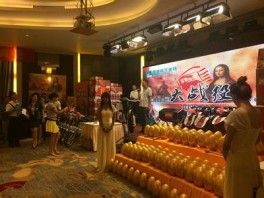On the Wei Wei Po, penned by their Chief Editor, Dr. Shuguang. 
達·芬奇的母親是「中國女奴」 尹樹廣 在北角一間海鮮酒家,我結識了義大利人安哥羅·帕拉提戈。他出書推斷達·芬奇的母親是「中國女奴」,招來同胞一片罵聲。 帕拉提戈五十多歲,光頭,中等個,身材結實,隨意穿著件紅花短袖衫,一笑透出亞平寧半島燦爛的陽光來。他告訴我,因半年多前在香港出版《達·芬奇 一位湮沒在意大利文藝復興中的中國學者》一書,推斷蒙娜麗莎的原型是達·芬奇的母親,為販賣到佛羅倫薩的「中國女奴」,許多義大利人罵他是「瘋子」,但他並不在意。 與帕拉提戈交談很愉快,無拘無束,思想像雲朵在歷史的天空中自在飄蕩。他在港生活二十多年,第一任妻子是位香港女子,香港融合東西方,他格外喜歡。我們不知不覺談起了他的老鄉、義大利傳教士利瑪竇。「為了在中國傳教,利瑪竇穿中國人的長衫,遵循中國人的風俗禮儀,不僅被中國人視為怪物,也被羅馬教庭和同胞責難。」帕拉提戈講話時很動情,似乎有「世人皆醉我獨醒」的苦楚。他的前輩馬可波羅和利瑪竇何嘗不是如此? 帕拉提戈的這本奇書由香港Lascar Publishing Limited出版社出版。他經過多年的研究試圖證明,達·芬奇的名畫《蒙娜麗莎》是以畫家的母親為原型繪製的,而她是從中國販賣到那裏的女奴,嫁給達·芬奇的父親後,非婚生下達·芬奇。帕拉提戈的「中國母親說」有不少證據,如《蒙娜麗莎》的背景是典型的中國山水畫圖案,達·芬奇用左手從左向右書寫,吃素等等,他歸結這是大師深受母親的祖國–中國的影響。帕拉提戈說,達·芬奇生活的二百年前,成吉思汗已征服幾乎整個歐亞大陸,打通了東西方大通道,後來又有帖木兒帝國稱雄一時,東西方之間奴隸貿易十分發達,達·芬奇母親很可能是被擄到義大利的。許是出身卑微,她的家世無任何歷史記載,至今成迷。 為了探究達·芬奇身世之迷,帕拉提戈幾乎走遍了大半個中國,也走遍了整個中亞地區。他說,自己是歷史學家,興趣廣泛,1997年一位英國學者首次提出羅馬軍隊曾到過中國西北,他於2001年考證并發表《在中國消失的羅馬軍團》文章,中國後來出版了許多這方面書籍,「不知道是不是受到我那篇文章的啟發?」這位義大利人想像力豐富,真讓人喜歡! 帕拉提戈做布料生意,是一間公司的副總。我問他生意如何?他笑著回答,「我不是個好商人,因為時間都用來搞歷史研究了。」與帕拉提戈交談時,我一直在想,他對東方的癡迷是不是繼承了義大利人浪漫率性的基因呢?他的血統與馬可波羅有沒有關系昵?他興趣廣泛,做事充滿激情,曾將《倫語》從英文翻譯成義大利文。 倘這位意大利「瘋子」明天有何驚人之舉,我不會感到奇怪的!
In a seafood restaurant in the North Point, I made my acquaintance with
Angelo Paratico. He is the man who has written a book, concluding that Mr.
Da Vinci was the son of a Chinese domestic slave girl. The book has caused a
big outcry as well as some protests from my countrymen.
Mr.. Paratico is around fifty, bare headed, of medium build, but sturdy, wearing
casually a short sleeve shirt with flowers, and with his broad smile coming
through the bright sunshine of the Alpine Peninsula where he was born. He told me that half
year ago, he published his book ‘Leonardo Da Vinci A Chinese Scholar Lost
in Renaissance Italy’. In the book, he concluded that Da Vinci’s mother was a
Chinese girl sold as a domestic slave girl to the Florence. She was the model for
the painting Mona Lisa. Many Italians called him nuts because of this. But he couldn’t care less.
My conversation with Angelo was very pleasant, unfettered, with our
thoughts floating like clouds in the historical space of Hong Kong. He has
been living Hong Kong for more than thirty years. His first wife was a
Chinese girl. Hong Kong has merged the East and the West, to his greatest
delight. We could not help talking about his countryman, Matteo Ricci, the
Italian missionary: ‘to bring the religion to China, he wore the Chinese
long gown, and abode with Chinese tradition and rites. As a result, he was
looked upon not only as a freak by the Chinese, but also rebuked by the
Roman Church and his own countrymen. He talked with emotion, seemingly
‘with pain in his heart that he was the only one sober among a crowd of
drunkards. In fact, did not his predecessor Marco Polo go through
the same emotions?
This unique book of Sr. Paratico was published by the Lascar Publishing
Ltd. Hong Kong. Through many years of research, he tried to prove that the
world famous painting ‘Mona Lisa’ was painted by Da Vinci with his mother as
its model. She in fact was a slave girl smuggled from China, had an encounter with his
father and had born the painter illegitimately. Paratico’s theory on the ‘Chinese
Mother’ has substantial evidences, e.g. the background of the Mona Lisa being
the typical Chinese landscape painting; Da Vinci using his left hand writing from
left side to the right side and remaining a vegetarian. He concluded that these
had been so because the Master was deeply influenced by the motherland of
his mother, China. Angelo Paratico went further to say that some two hundred
years before Da Vinci’s life time, Genghis Khan had almost conquered the
whole European and Asian Continents and brought forth the grand
thoroughfare between the East and the West. Later on, the Empire of Timur
Khan became the super power at the time and the slave trade between the
two was expanding and flourishing. It was quite possible that Da Vinci’s
mother was kidnapped and then moved to Italy. Probably because of her humble origin, her
birth and family were not recorded and remaining a puzzle up to now.
In order to investigate the puzzle of the birth and life of Mr. Da Vinci,
Paratico had almost set his feet on more than half of the Chinese territories,
and the whole of the Middle Asia. He said that he was a historian with a wide
variety of interests. In 1997, he noted that one British scholar suggested for
the first time that the Roman Legions were once in the Northern-Western
China. He followed it up, and in 2001 published a paper <the Disappearance of
The Roman Legions in China>. Thereafter many books were published in these
areas in China. ‘It is wondered if they were tipped off by my paper’. It is so
delightful, finding this Italian gentleman full of such imagination.
Paratico is in the fabric business. I asked him how was the business?
He answered, smilingly, ‘All my spare time is being put into the study of history.’
During my conversation with him, I could not stop thinking if his infatuation with the East
springs from his Italian romantic and straight forward DNA? Does his blood lineage have any relation
with Marco Polo? He has extensive and wide range interests and he works
with emotions. He even once translated the ‘Confucian Analects’ the Lun Yu from English
into Italian.
If this Italian bizarre character should have some spectacular new acts tomorrow, I won’t be
surprised even a bit.
